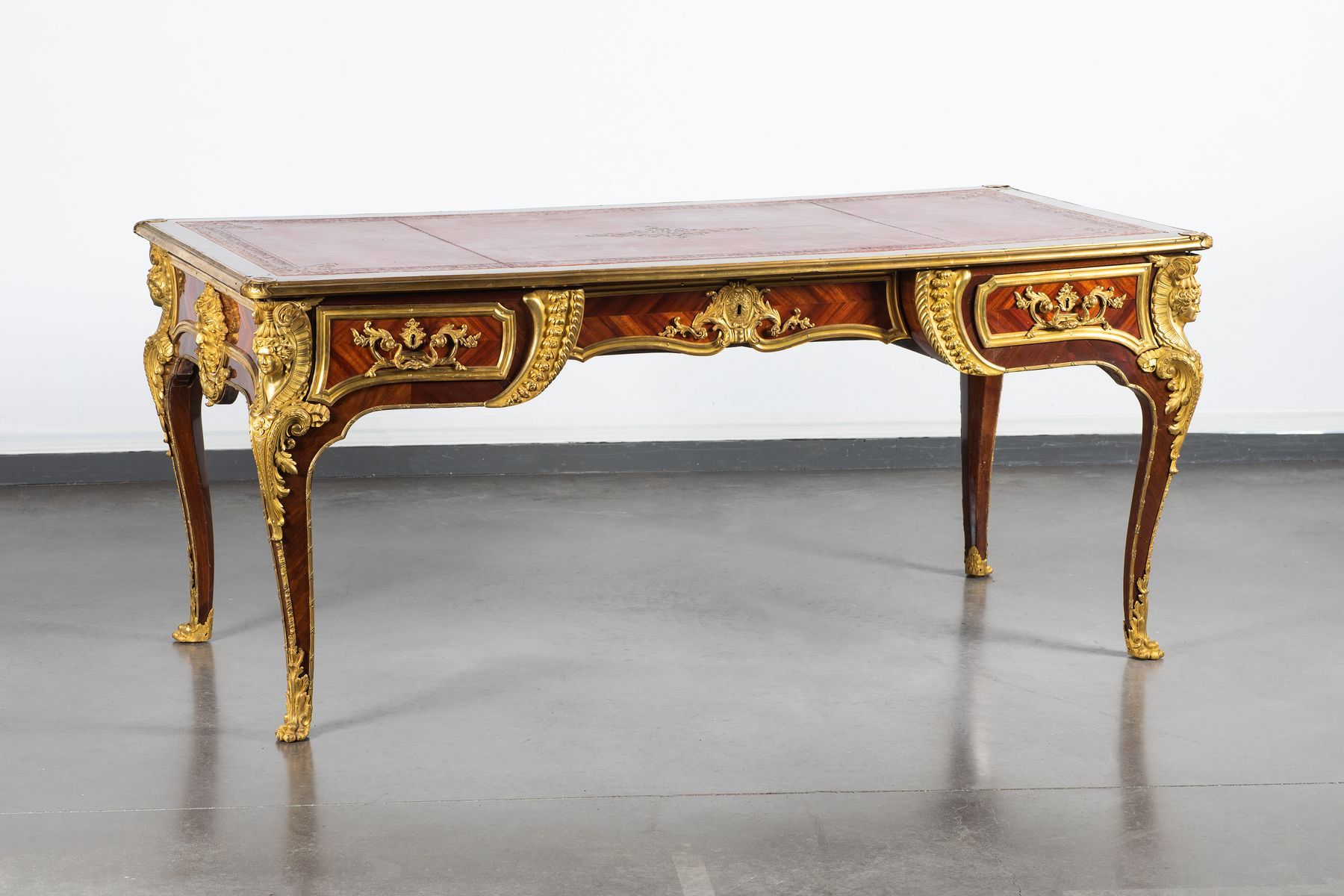Description
Exceptional and important flat desk called "minister's desk" with double face, in marquetry of satin and amaranth, very rich ornamentation of chased and gilded bronzes. It opens with three drawers in the belt, the central one in recess, and presents three simulated drawers on the visitor side. The top is lined with red leather with vignettes and gilded motifs. Superb ornamentation of chased and gilded bronzes: heads of women wearing a shell at the corners, masks of Bacchus on the sides, clawed hooves with leaves, handles and keyholes, moldings. Dismountable piece of furniture, the tray is maintained by a set of screws, these removed the entire dismantling of the furniture is possible. The most important bronzes struck with the "C crowned" (1745-1749) - Regency period (small accidents to the veneer of the tray, restorations of use and maintenance. The most important bronzes with the crowned C) Height 79.5 cm - Width 178 cm - Depth 88 cm Attributed to Charles CRESSENT (1685-1768) Born in Amiens, his father was a sculptor, his grandfather was a furniture maker and also a sculptor. Received in 1714 at the academy of Saint Luc, he settles in Paris. In 1719, he becomes supplier of the Duke of Orleans. His clientele includes the high ranking aristocracy and the great collectors. His talents as a sculptor lead him to make the model of his bronzes himself and to have them made in his workshops. Several similar models can be found in the reference book "Charles CRESSENT sculptor, cabinetmaker of the regent" by Alexandre PRADERE, Editions FATON 2003 - The same handles and the same central lock entrance, page 126, on the old BENSIMON collection desk - The same heads of women and masks of Bacchus, page 115, on the desk, former collection of Madame de BEHAGUE
152
Exceptional and important flat desk called "minister's desk" with double face, in marquetry of satin and amaranth, very rich ornamentation of chased and gilded bronzes. It opens with three drawers in the belt, the central one in recess, and presents three simulated drawers on the visitor side. The top is lined with red leather with vignettes and gilded motifs. Superb ornamentation of chased and gilded bronzes: heads of women wearing a shell at the corners, masks of Bacchus on the sides, clawed hooves with leaves, handles and keyholes, moldings. Dismountable piece of furniture, the tray is maintained by a set of screws, these removed the entire dismantling of the furniture is possible. The most important bronzes struck with the "C crowned" (1745-1749) - Regency period (small accidents to the veneer of the tray, restorations of use and maintenance. The most important bronzes with the crowned C) Height 79.5 cm - Width 178 cm - Depth 88 cm Attributed to Charles CRESSENT (1685-1768) Born in Amiens, his father was a sculptor, his grandfather was a furniture maker and also a sculptor. Received in 1714 at the academy of Saint Luc, he settles in Paris. In 1719, he becomes supplier of the Duke of Orleans. His clientele includes the high ranking aristocracy and the great collectors. His talents as a sculptor lead him to make the model of his bronzes himself and to have them made in his workshops. Several similar models can be found in the reference book "Charles CRESSENT sculptor, cabinetmaker of the regent" by Alexandre PRADERE, Editions FATON 2003 - The same handles and the same central lock entrance, page 126, on the old BENSIMON collection desk - The same heads of women and masks of Bacchus, page 115, on the desk, former collection of Madame de BEHAGUE
